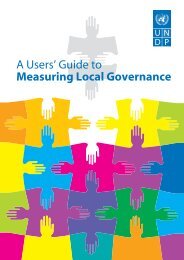planning a governance assessment - United Nations Development ...
planning a governance assessment - United Nations Development ...
planning a governance assessment - United Nations Development ...
Create successful ePaper yourself
Turn your PDF publications into a flip-book with our unique Google optimized e-Paper software.
4. The Urban Governance Index (UGI) by UN Habitat<br />
The UGI uses 25 indicators across four sub-indices. The <strong>assessment</strong> process includes participants from civil society<br />
organizations, associations of local government, ministries of local government, or coalitions of these key actors to design<br />
their own urban <strong>governance</strong> indicator systems.<br />
Effectiveness<br />
• Local government revenue per capita<br />
• Ratio of actual recurrent and capital budget<br />
• Local government revenue transfers<br />
• Ratio of mandated/actual tax collection<br />
• Predictability of transfers in local government budget<br />
• Published performance delivery standards<br />
• Consumer satisfaction survey<br />
• Existence of a vision statement<br />
Equity<br />
• Citizens’ charter: right of access to basic services<br />
• Percentage of women councilors in local authorities<br />
• Pro-poor pricing policies for water<br />
• Incentives for informal businesses<br />
Participation<br />
• Elected council<br />
• Selection of mayor<br />
• Voter turnout<br />
• Public forum<br />
• Civic associations per 10,000 population<br />
Accountability<br />
• Formal publication<br />
(contracts and tenders; budgets and accounts):<br />
• Control by higher levels of government<br />
• Codes of conduct:<br />
• Facility for citizen complaints<br />
• Anti-corruption commission<br />
• Independent audit<br />
Conclusions, costs and benefits of how you define <strong>governance</strong><br />
As you can see, these frameworks share many of the same elements, such as transparency, accountability, participation,<br />
and efficiency, among others. They also examine these elements of <strong>governance</strong> across similar areas of society. A concise<br />
definition that lends itself to a well-defined and developed framework saves money and time. Between the examples<br />
provided above and the dozens of examples offered in the UNDP Governance Indicators Guide, stakeholders have plenty to<br />
think about when deciding on how to develop a country-led <strong>governance</strong> <strong>assessment</strong>. Whatever approach fits the situation<br />
best, it is wise to use theory and previous research as a guide. At the very least, there should be several indicators for each<br />
dimension of <strong>governance</strong> examined, in each area of society and/or government. The following section addresses the next<br />
step in the process: identifying existing <strong>governance</strong> indicators and developing new ones.<br />
22<br />
Planning a Governance Assessment: A Guide to Approaches, Costs and Benefits








![GuÃa del Usuario ] - Governance Assessment Portal](https://img.yumpu.com/44740603/1/190x253/gua-a-del-usuario-governance-assessment-portal.jpg?quality=85)







